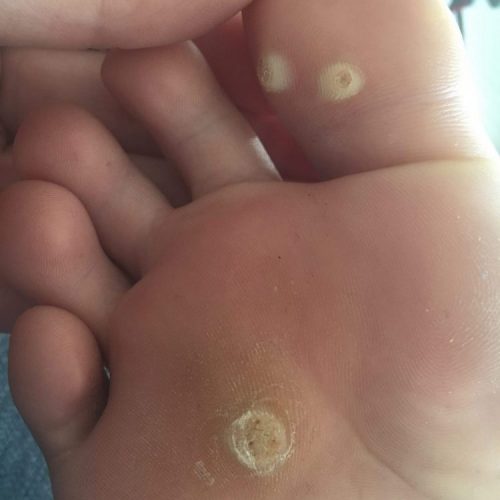A foot virus
A foot virus is commonly known as verrucae or warts. Verrucae or warts are known by health professionals as the human papilloma virus (HPV). There are over 100 HPV subtypes which can look slightly different on the skin.
What is a virus?
A virus is a tiny agent which can infect living organisms (host). The virus can copy itself inside our cells, it takes over the cell machinery and reproduces itself. The cell then bursts open, spreading the virus. There is a barrier around them making it hard for our body’s defence mechanism to locate them. Viruses infect a variety of living organisms, including bacteria, plants, and animals.
The HPV (human papilloma virus)
The HPV infects the skin cells in the outer layer of skin (epidermis) where it can stay undetected. They are harmless in that they don’t invade the body any deeper than the top layer of skin. They can however spread to other parts of the foot or onto the hands.
The virus causes an excess amount of keratin to develop in the top skin layer (epidermis). The extra keratin produces the unsightly and rough texture of the verrucae and wart.
Are you sure it is a verrucae?
It is common for people to misdiagnosis a verruca, with a corn or a foreign body. If you are unsure do contact a podiatrist for confirmation as these conditions would require very different treatments.
How does it spread?
A foot virus / HPV is picked up by barefoot contact on floors and surfaces. This is most common in wet changing room floors and shower areas. The HPV can survive for up to 3 weeks without a host. The virus can lie dormant in the skin cell for up to 8 months after exposure.
The virus is passed from one person to another by infected skin cells falling off. When someone walks over the skin cells if their skin is vulnerable they may contract the virus.
Vulnerable skin can be:
- very dry skin
- very wet/damp skin
- skin that has by microscopically abraded ie scuff in skin
Who gets verrucae and warts?
The HPV is so common that it is thought most people will have them at some point in their life. They are commonly seen in children, teenagers and young adults. Patients whose immune system is suppressed by drugs or a medical condition as well.
There is an estimate that it occurs in between 5 – 30% of children and young adults.
How does our body fight this virus?
Our immune system is designed to do this job (own immune response). It will monitor, recognise, and even remember the virus. Recognition of the virus is through the viral proteins within the skin cell around the virus. The immune system will take action to eliminate it when the virus invades healthy cells.
The immune system does this by releasing chemicals that trigger virus-fighting cells. These cells are then sent to wipe out the enemy. Most resolve naturally in adults on average within 8 years and in children within 2 years.
However the viral proteins can inhibit the body’s reaction to the virus and as such the body remains ‘ignorant’.This means no action is taken and the virus remains.
Treatments for HPV (a foot virus)
The aim of all treatments for HPV is to destroy the virus infected skin cells and provoke the body’s own immune response. As described above our immune response should take action and eliminate, thus kill the virus from within.
There are a number of treatment options. All have success variations.
- No treatment – rely on body’s own immune response
- Salicylic acids – destroy skin and burn out viral infected skin tissue, provoke an immune response
- Cryotherapy – destroy skin cells and provokes an immune response
- Microwave therapy – destroy tissue and provokes an immune response
- Removal – aims to remove all viral skin cells
If you would like to come and see us for a verrucae treatment, please contact us direct or book online.


